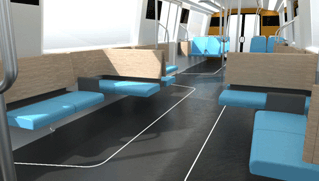How will BART's Fleet of the Future help ease crowding on the train?
BART into the future
BART is planning to replace its aging cars with a “Fleet of the Future.” The new cars will help keep BART running on time and lessen crowding on the trains. With gas prices spiraling through the roof, and increasing traffic, many drivers are turning into BART riders. In fact, BART ridership has reached an all-time high of 376,000 riders on weekdays as more and more drivers find themselves wanting to become BART riders instead of sitting in gridlock with nothing much to do except fume angrily while burning that oh, so expensive gas.

Revised interior design, March 2012.
Meanwhile, it’s no secret that finding a place to sit on BART’s current crop of train cars can be challenging during rush hour periods.
BART is doing all it can in the short-term to accommodate our newest customers by keeping its train car in service with less down time for maintenance and repairs;.
But what does the agency have planned to help ease the crowding issues onboard the “Fleet of the Future?” Let’s BART into the future and take a glimpse of some of the preliminary design features BART is considering on-board the new trains when they start appearing after 2018:
- A bigger fleet means more seats: We are seeking funding to expand the number of cars in the BART fleet from 669 currently to 775 which could increase the number of seats significantly.
- More doors: New cars will have three doors on each side of a train car instead of two--which makes getting on and off faster and easier. This will be an important part of getting more trains and more capacity onto the BART system to meet increasing ridership over the next 30-to-50 years. We recognize the need to provide as much seating as possible, especially for customers taking longer trips on BART.
- Bike racks on trains: This will better accommodate bicyclists during hours when bikes are permitted on BART.
- More priority seating for seniors and people with disabilities.
- Higher seats mean more storage space: BART seats will be mounted higher off the floor on the new train cars, making the seats easier to get up from and increasing the amount of space under the seats to stow luggage. Also, preliminary designs for the new fleet include open seating areas designed to accommodate riders who want to keep their luggage close to them, customers with strollers, and customers who want a little more legroom.
- More service - fewer transfers: The new cars will enable BART to split trains at transfer stations, and send each part to a different destination. This could provide more customers with direct service to their destination without transferring to another train on evenings and Sundays when some BART routes do not operate.
- More handholds: BART plans to increase the number of poles, handholds, and/or hand straps to better meet the needs of those who cannot reach overhead stanchions, as well as elderly and disabled customers who have told us they want more handholds near the doors to avoid losing their balance as trains accelerate or decelerate.